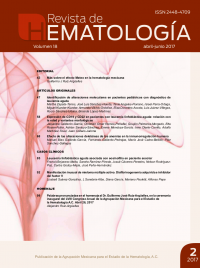Rev Hematol Mex. 2017 abr;18(2):58-67.
Calderón-García J2, Ramos-Peñafiel CO1,2,3, Palmeros-Morgado G4, Rozen-Fuller E5, Santoyo-Sánchez A1,2, Mendoza-García E4, Olarte-Carrillo I3, Martínez-Tovar A3, Collazo-Jaloma J5
1 Facultad de Medicina, Universidad Nacional Autónoma de México, Ciudad de México, México.
2 Servicio de Hematología.
3 Laboratorio de Biología Molecular.
4 Laboratorio de Hematología-Área diagnóstica: Citometría de flujo.
5 Laboratorio de Hematología-Área diagnóstica: Morfología.
Hospital General de México Dr. Eduardo Liceaga, Ciudad de México, México.
Resumen
ANTECEDENTES: la citometría de flujo es una herramienta diagnóstica aplicada en casos de leucemia linfoblástica aguda para identificar los marcadores de las clonas neoplásicas y clasificar la estirpe y grado de maduración.
OBJETIVOS: establecer la frecuencia de expresión de los marcadores CD19 y CD22 e identificar si existe variación de expresión entre los diferentes grupos de edad.
MATERIAL Y MÉTODO: estudio retrospectivo, transversal, observacional, basado en los registros de pacientes atendidos de julio de 2009 a junio de 2015 con diagnóstico de leucemia linfoblástica aguda de novo. Las muestras para inmunofenotipo por citometría de flujo fueron médula ósea o sangre periférica en pacientes con hiperleucocitosis o difícil toma de médula ósea; las muestras debían contener más de 20% de blastos.
RESULTADOS: se estudiaron 208 casos, con media de edad de 32 (2-88) años. El 68% (n=141) fueron muestras de médula ósea y el resto de sangre periférica (32%, n=67). Se identificó que 193 casos (93%) mostraban inmunofenotipo de línea B, 12 de estirpe T (5.5%) y 3 fueron no clasificables (1.5%). La variante B común fue el fenotipo más frecuente en todos los grupos de edad. El 90% de los casos (n=176) fueron CD22+, con media de expresión de 63%. El 91% (n=179) fue CD19+, con media de expresión de 76%. La edad no influyó en la expresión de estos marcadores (p>0.05).
CONCLUSIONES: los marcadores celulares analizados se expresaron frecuentemente, sin afectarse por la edad del paciente. Es indispensable la realización del inmunofenotipo en los pacientes con leucemia linfoblástica aguda para ofrecerles tratamientos altamente específicos.
PALABRAS CLAVE: antígenos de superficie, antígenos CD19, leucemia-linfoma linfoblástico de células precursoras, citometría de flujo, grupos de edad.
CD19 and CD22 expression in patients with acute lymphoblastic leukemia: relationship with age and morphological variants.
Rev Hematol Mex. 2017 Apr;18(2):58-67.
Calderón-García J2, Ramos-Peñafiel CO1,2,3, Palmeros-Morgado G4, Rozen-Fuller E5, Santoyo-Sánchez A1,2, Mendoza-García E4, Olarte-Carrillo I3, Martínez-Tovar A3, Collazo-Jaloma J5
1 Facultad de Medicina, Universidad Nacional Autónoma de México, Ciudad de México, México.
2 Servicio de Hematología.
3 Laboratorio de Biología Molecular.
4 Laboratorio de Hematología-Área diagnóstica: Citometría de flujo.
5 Laboratorio de Hematología-Área diagnóstica: Morfología.
Hospital General de México Dr. Eduardo Liceaga, Ciudad de México, México.
Abstract
BACKGROUND: Flow cytometry is a diagnostic tool applied in cases of acute lymphoblastic leukemia (ALL) to identify markers in neoplastic clones and to classify the lineage and maturation degree.
OBJECTIVES: To establish the frequency of CD19 and CD22 expression and to identify if there is variation of expression between the different age groups
MATERIAL AND METHOD: A retrospective, cross-sectional, observational study based on the records of patients attended from July 2009 to June 2015 with diagnosis of de novoALL. The samples for immunophenotype by flow cytometry were bone marrow or peripheral blood in patients with hyperleukocytosis or difficult to obtain bone marrow. Samples should contain >20% blasts.
RESULTS: A total of 208 cases were studied with a mean age of 32 (2-88) years old. The 68% (n=141) were samples of bone marrow and the rest of peripheral blood (32%, n=67). It was identified that 193 cases (93%) showed B-type immunophenotype, 12 of T-lineage (5.5%) and 3 were non-classifiable (1.5%). The common B variant was the most frequent phenotype in all age groups. The 90% (n=176) was CD22 +,
with a mean expression of 63%. The 91% (n=179) was CD19+, with a mean expression of 76%. Age did not influence expression of these markers (p>0.05).
CONCLUSIONS: The analyzed cell markers were frequently expressed, unaffected by the patient’s age. The immunophenotype in ALL patients is indispensable to offer them highly specific treatments.
KEYWORDS: antigens; surface antigens; CD19; precursor cell lymphoblastic leukemia-lymphoma; flow cytometry; age groups

